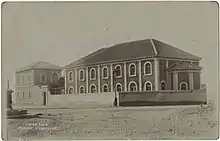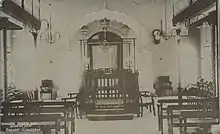Magain Shalome Synagogue
The Magain Shalome Synagogue (Urdu: مگین شلوم کنیسہ; Hebrew: בית הכנסת מגן שלום) was a synagogue in Karachi, Pakistan. The synagogue was built by Solomon David Umerdekar in 1893.[1][2]
| Magain Shalome Synagogue בית הכנסת מגן שלום مگین شلوم کنیسہ | |
|---|---|
 The synagogue in 1893 | |
| Religion | |
| Affiliation | Orthodox Judaism |
| Rite | Sephardic |
| Status | Demolished 1988 to make way for a shopping plaza |
| Location | |
| Location | Corner Synagogue Street (officially renamed Jamila Street) & Nishtar Road in Kalanagar, Ranchore Line |
| Architecture | |
| Completed | 1893 |
History
The synagogue built in 1893, and was extended in 1912 by Umerdekar's two sons, Gershon Solomon Umerdekar and Rahamim Solomon Umerdekar. A community hall named “Shegulbai Hall” was built by Abraham Reuben Kamerlekar in memory of Shegulabai Solomon Umerdekar.
In 1916-18 the Karachi Jewish community opened a Hebrew school on the synagogue premises and in 1918 constructed the Nathan Abraham Hall. There was a signboard on the synagogue, reading as “Pakistan Bene Israel Association”, “Bani Israel Masjid” and also something like, “Only Jewish people are allowed to enter this place”.[3]
The synagogue soon became the center of a small but vibrant Jewish community, one of whose leaders, Abraham Reuben, became a councilor on the city corporation in 1936. The synagogue was set on fire in 1948 following the establishment of Israel, and several Jews were attacked, many of whom fled to India.[4][5] The frequency of attacks increased after each of the Arab-Israeli wars in 1948, 1956 and 1967 and by the 1960s the synagogue became dormant.[5] On July 17, 1988, the Magen Shalom synagogue was demolished[5] to make way for a shopping plaza (Madiha Square) in the Ranchore Lines neighborhood of Karachi.
In 1989, the original Ark and podium were stored by a Gentile in Karachi; a Torah scroll case was taken by an American Jew to the US. In 2004 she donated synagogue registers covering the period 1961-1976 to the Ben-Zvi Institute Library in Jerusalem. In these ledgers, a circumcision was recorded in 1963 and several weddings in 1963-64. In 1973 only 15 names were written down, of whom nine were listed as “left Karachi”.[6]
Gallery
 Interior of the synagogue
Interior of the synagogue Synagogue entrance
Synagogue entrance Fountain in the courtyard
Fountain in the courtyard Synagogue's Rabbi in 1951
Synagogue's Rabbi in 1951
References
- "Archived copy". Archived from the original on 2010-11-08. Retrieved 2011-02-16.CS1 maint: archived copy as title (link)
- Corroborated by the encryption on the gravestone of Mr. Soloman David and an interview with Mr. Emanuel Matat who was born and lived for about thirty years in Pakistan and prayed in Magen Shalom.
- "Archived copy". Archived from the original on 2010-11-08. Retrieved 2011-02-16.CS1 maint: archived copy as title (link)
- Daiya, Kavita (2011-02-04). Violent Belongings: Partition, Gender, and National Culture in Postcolonial India. Temple University Press. p. 129. ISBN 978-1-59213-744-2.
- "No more in Karachi". DAWN.COM. 2010-02-27. Retrieved 2020-12-05.
- "Archived copy". Archived from the original on 2010-11-08. Retrieved 2011-02-16.CS1 maint: archived copy as title (link)